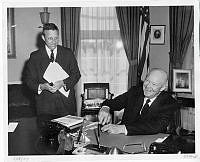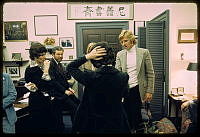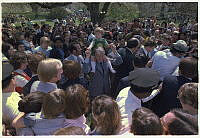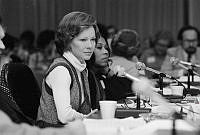Lucretia Garfield

Lucretia Rudolph was born on April 19, 1832 to Arabella Mason and Zebulon Rudolph. She acquired her love of learning from her father, and was well educated for a woman of her day who enjoyed translating Greek and Latin. She first met "Jim" Garfield when both attended Geauga Seminary, and they renewed their friendship in 1851 as students at the Western Reserve Eclectic Institute.
However, "Crete" did not attract his special attention until December 1853, when he began a rather cautious courtship, and they did not marry until November 11, 1858, when he was well established in his career as a teacher. His service in the Union Army from 1861 to 1863 kept them apart; their first child, a daughter, died in 1863. But after his first lonely winter in Washington as a freshman Representative, the family remained together. With a home in the capital as well as one in Ohio they enjoyed a happy domestic life. A two-year-old son died in 1876, but five children grew up healthy and promising; with the passage of time, Lucretia became more and more her husband’s companion.
In Washington they shared intellectual interests with congenial friends; she went with him to meetings of a locally celebrated literary society. They read together, made social calls together, dined with each other and traveled in company until by 1880 they were as nearly inseparable as his career permitted. Although she held strong views on women's rights and independence, she did not publicly disagree with her husband on issues.
Garfield’s election to the presidency brought a cheerful family to the White House in 1881. Though Mrs. Garfield was not particularly interested in a first lady’s social duties, she was deeply conscientious and her genuine hospitality made her dinners and twice-weekly receptions enjoyable. She also reintroduced alcohol to the White House after her predecessor Lucy Hayes's ban and when tasked with overseeing White House renovations, went to the Library of Congress to research the history of the executive residence in order to furnish it in historical style.
In late April 1881 she fell gravely ill, apparently from malaria and nervous exhaustion, to her husband's profound distress. She was still convalescing at a seaside resort in New Jersey, when he was shot by an assassin on July 2. She returned to Washington quickly by special train to be by his side.
During the three months her husband fought for his life, her grief, devotion, and fortitude won the respect and sympathy of the country. In September, after his death, the bereaved family went home to their farm in Ohio. For another 36 years she led a strictly private but busy and comfortable life, active in preserving the records of her husband’s career. She died on March 13, 1918.





































